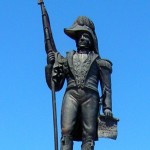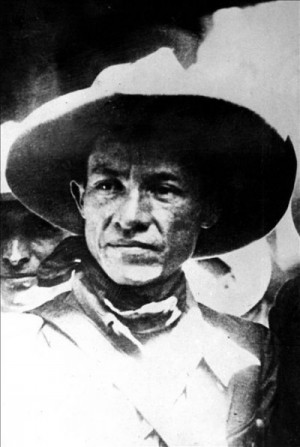Is This the Authentic Face of Toussaint L’Ouverture?
By Patrick Sylvain
Boston Haitian Reporter
“Images are not arguments, rarely even lead to proof, but the mind, craves them, and, of late more than ever, the keenest experiments find twenty images better than one, especially if contradictory; since the human mind has already learned to deal in contradictions.” — Henry Adams, A Law of Acceleration
If there is one important historical figure from the early nineteenth century who has been consistently misrepresented through imagery, it would have to be Toussaint L’Ouverture. One would think that at a minimum, someone of his ilk and significance to Haitian history and the overall contribution to humanity’s fight for equality, freedom and dignity, a proper physical representation of his figure would be easily accessible. However, this has not been the case.
As we know, images are powerful tools. Unfortunately, they are often conjured and perpetuated by the victors of history, and are thus prone to re-imaging and propaganda. Predictably, the essence of Toussaint over the years has suffered a vast distortion and vilification that has been seared into our minds as we remember him as a figure that was either homely and diminutive, or at times ostentatious and imposing – perhaps not representative of his legacy.
In March of last year, after Haiti’s tragic earthquake, a friend of mine, researcher Mario Valdes, whom I had the opportunity to work with at PBS Frontline, e-mailed me a photograph of what may be the only historically accurate painting of Toussaint, shattering any and all previous notions I held about his physical appearance and affect.
In his email, Valdes wrote:
“This portrait by the son of Rene Louis de Girardin, the patron of the great French philosopher, Jean Jacques Rousseau, represents Toussaint as the ideal revolutionary. It is not the figure of the ferocious dictator he later became and which has dominated the political ethos in Haiti for the last two centuries. It is, therefore, this image and all that it philosophically stands for that has to prevail if Haiti is billed as the world’s first black republic.”

Portrait of Toussaint L’Ouverture by Alexandre Francois Girardin: recently discovered and possibly the only historically accurate painting of the Haitian leader.
The remarkable details of Giradin’s painting are lucidly captured in the photograph: the intensity of light emitted by the tropical sun, the mountains that are ever present in the Haitian landscape, the razor bumps on his chin, his famous silver hoop earring, and the exacting details of his uniform, from the brass buttons to cordons epaulettes, and fluffy, colorful plumes.
Toussaint looked like someone who was in his late forties or early fifties, neither youthful nor aged, and his features were neither grotesque nor idealized. Unlike some other paintings that made him at times look like royalty from a bygone chapter in ancient Greco-Roman history, or simply as a man who was so atrocious looking that the mere sight of him was enough to repulse you. This newly revealed, more realistic version of Toussaint was a welcome sight, and the renowned Haitian art historian Michel-Philippe Lerebours concurred with my conclusion and was pleasantly astounded by the imagery.
As I am mired in Haiti’s history and perplexed by its rapid acceleration into the abyss, I also want to hold on to the uniqueness of the place, the bravery as well as the shortcomings its heroes and heroines.
Imagery is everything. So, I’ve desired to erase from my mind the brutish images that were taught to me at school about Toussaint as well as the repeated absurd lines of how ugly and skinny he was (baton fatra), and embrace a more positive, realistic depiction of his likeness. This act urges me to consider the historical implications of how Toussaint has been depicted over the years.
Soon after the revolution started in 1791 to this day, but particularly after 1804, the slave-owning world despised Haiti and its radical black leaders. News of what were considered terrifying events of the revolution took on vile racialized tones and created a discourse that inevitably placed Haiti on the wrong side of history. Toussaint, the premier, the architect of that glorious revolution, became the first victim of misrepresentation.
As Charles Forsdick aptly articulated, Toussaint’s memory was
“a contested territory.”
It was Maurin’s 1832 grotesque lithograph that served as the commonly accepted visual representation of Toussaint. Despite protests by Isaac, Toussaint’s son, that he was hardly able to recognize his father in the depiction, copies quickly circulated and gained wide acceptance.
In a different, but also well-known representation constructed by M. de Montfayon, an engineer who served under General Toussaint, Loverture is depicted as almost Caucasian. Dr. Fritz Daguillard comments:
“in fact, these two portraits influenced all future depictions of Louverture. Our hero was henceforth to become a mixture of the features ascribed to in these works.”
I, for one, view the image recently relayed to me by Mario Valdes as a tool to help excavate the past, for its likely accuracy is difficult to contest.
To quote Valdes:
“To judge from the expertise exhibited in the work, this is undoubtedly the most important representation of Toussaint L’Ouverture discovered to date. Because of the high realism this 25 5/8 X 21 3/8 inches oil on canvas offers in comparison to the dozen or so 19th century frontis page engravings extant, and which it is important to note, are quite different from one another, this work by the still relatively unknown French artist, Alexandre Francois Girardin, is, therefore, the most authoritative image of the celebrated general we now know.”
The caricatures of Toussaint became the caricature of Haiti, and Haitians unfortunately replicated the racial stereotypes that their former slave masters fed them in their contempt for Toussaint.
The real image of Toussaint L’Ouverture has remained for too long in obscurity and it is time that we restore his dignity, the proper narrative and not a romanticized one, that he rightly deserves. And it is also time that Haiti’s national treasures become a part of the patrimony so that future generations can be connected to their past and not suffer from historical amnesia and destruction.
I am thankful for Mario Valdes’ thorough research in this matter, and hope that Giradin’s original portrayal of Toussaint will one day be safely housed in a protected Haitian museum.
“The painting was last sold in 1993 as part of the estate of a New York art dealer and went for $14,000.00. A couple of years previously, the dealer had picked it up for about $9,000.00 at the auction of a collection of primarily 20th century Haitian art, the owners of which had, in turn, paid $2,000.00 for it at a sale in ‘87. This is as much of the provenance I have of this piece to date.”
The long-standing misrepresentations of Toussaint must be buried in order for Haiti to rebuild anew. Sovereignty must not only be territorial and political, it must also be psychological, representational and educational.
Sources: Boston Haitian Reporter | Haiti Chery | Patrick Sylvain is an Instructor of Haitian Language and Culture at Brown University and a Contributing Editor at Boston Haitian Reporter.







Comments
Is This the Authentic Face of Toussaint L’Ouverture? — No Comments